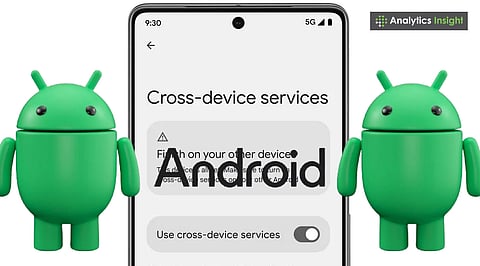

Start a task on one Android device and continue it on another without losing progress.
Broad support for Android phones, tablets, and Windows PCs via Continuity SDK.
Secure, encrypted cross-device transitions, keeping user data private and local.
Google is finally bringing a native cross-device task continuity feature to Android, called Google Handoff. Expected to debut with Android 17, this system-level feature allows users to start a task on one device and seamlessly continue it on another, without losing progress or context. Reading a document on a smartphone and then switching to the tablet or PC, Google Handoff promises an uninterrupted and natural workflow.
Unlike other third-party apps that have tried to bridge devices previously, Google Handoff is natively integrated into the Android operating system. This offers smoother transitions, faster performance, and consistency across all supported devices. The feature also leverages Android’s Private Compute Core, securing sensitive session information and keeping it local to your device.
Apple has had the Handoff feature, allowing users to transition tasks among iPhone, iPad, and Mac with nearly perfect continuity for some time. Android, on the other hand, has been hampered by device fragmentation, varied manufacturer tweaks, and non-unified integration.
With Google Handoff, Android is bridging that gap. The feature utilizes device detection to identify nearby compatible devices that are logged in with the same Google account. Task states such as scroll positions, open tabs, and app sessions are saved, and a task icon is visible on the receiving device for resumption at will.
Additionally, Google is taking it one step further by allowing cross-platform integration. Windows PCs running the Continuity SDK can now join the Android workflow, a capability Apple cannot replicate natively. Essentially, Android Handoff isn’t merely playing catch-up; it’s setting itself up as a potentially more fluid solution for multi-device productivity.
Android Handoff for multi-device workflow is intended to span a broad range of devices:
Android Phones: All Android 17 and later.
Tablets: Android tablets that fit the compatibility criteria will enable task resumption.
PCs: Windows PCs equipped with Google’s Continuity SDK can display task icons directly on the taskbar, allowing for immediate task resumption.
This broad interoperability means users can switch between phones, tablets, and PCs without fear of device restriction, and Google Handoff is thus more universal than Apple’s ecosystem.
Security and privacy are the cornerstones of Google Handoff. The task states are held entirely within the Android Private Compute Core so that absolutely no access or data leak can occur. The data transfer is end-to-end encrypted to keep the confidential data safe when it moves across different devices.
If you consider your privacy critically, you will understand that this solution ensures that task information, such as a half-written email, a research paper, or an open browsing session, will only reside on trusted devices and will never be sent without the user’s consent.
Also Read: Android 16 Update: Features and Eligible Smartphones
Using Android Handoff for a multi-device workflow is easy. After enabling it, begin a task on any supported device. Nearby compatible devices will automatically pick up the open session. The task continuation icon then shows up on the taskbar or notification panel of the receiving device. Tap the icon to continue the task right where it left off.
The workflow is also flexible, accommodating productivity apps, media streaming, and even intricate document editing. For multitaskers and working professionals, this can be a significant time-saver, eliminating the need to open apps or manually search for the last-used page.
Also Read: Google Plans on Building Android for PCs, Qualcomm CEO Calls It ‘Incredible’
Google Handoff represents a significant shift for Android users. They can now multitask between devices the way Apple users have always done, plus with the added advantage of vastly increased device compatibility. For individuals who use two or more devices, the feature brings significant improvements in their productivity, enhancing workflow processes and reducing friction between tasks.
By combining seamless task pickup, robust security, and cross-device flexibility, Google Handoff is poised to solidify Android’s position in the competitive cross-device ecosystem market. It indicates that Android is not only closing the gap on Apple but also potentially provides a more adaptive method of device integration.
What is Google Handoff?
Thanks to Google Handoff, one can start a task on one Android device and continue it on another compatible device.
Which devices support Google Handoff?
Named phones of Android 17, tablets of compatibility, and Windows PCs with the Continuity SDK support Google Handoff in multi-device workflows.
Is Google Handoff secure?
Task data remains on-device inside the Android Private Compute Core, while transmissions between devices are encrypted to ensure the highest level of privacy.
How do I use Google Handoff?
Switch on Handoff, begin a task, and then tap the task icon on a nearby compatible device to continue immediately.
How does an Android Handoff compare to an Apple Handoff?
Aggregated content originates from the specified services and is routed through the Mesh platform to the end-user screens, with Verizon Networks and Channel Multimedia combining their content services platform.
